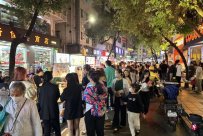
After the return of full customs clearance on February 6, Shenzhen Hong Kong has increased rapidly.The flow of personnel has accelerated the recovery of commercial activities near the port, but different industries and port recovery are different.
Mainland China and Hong Kong have been fully cleared up for two months. The retaliatory consumption model near the Hong Kong port is promoted to the recovery of all walks of life, but the recovery of different industries and ports is different.The demand for the catering service industry near Shuimi Village near Futian Port has increased greatly; the retail industry next to Luohu Port has no obvious recovery, and some merchants lament that they often have "open markets".
Shenzhen and Hong Kong resumed the full customs clearance on February 6 this year, and officially bid farewell to the entry and exit restrictions of the two places under the epidemic in the past three years.After the customs clearance is constantly, the passenger flow from Hong Kong has increased rapidly.According to data from the Shenzhen Municipal Government Port Office, the entry and exit personnel of the Shenzhen Port exceeded 7.3 million in February this year, an increase of about 2230%year -on -year.
Shenzhen Shuiwei Village has restored the bustling scene of the past
Personal flow accelerates the recovery of commercial activities near the port.Shuiwei Village, Futian District, Shenzhen has restimmed to the bustling scene of the past.Lianhe Zaobao visited the Qingming holiday (April 5th) and Qingming holidays (April 5th), and found that almost all shops had resumed business, and the food industry was in the market and there was no seat.
Shuiwei Village is about one kilometer from Futian Port. It is a famous "city village" in Shenzhen. It brings together hundreds of famous food, foot therapy massage and other stores. It is a place for Hong Kong passenger transit consumption and gathering.However, the sealing of the epidemic in the past three years has led to the loss of customers in Hong Kong. Shuiwei Village has also been blocked for many outbreaks. Non -residents are prohibited from entering the village. Many shops have been forced to close because they cannot survive.
Zhou's accountant at a hot pot restaurant in Shuiwei Village told Lianhe Zaobao that at least 60%of the shops were closed during the epidemic period. At present, most businesses are reopened after customs clearance in Shenzhen and Hong Kong.She said that the flow of people has only returned to about 50%before the epidemic, but the catering industry and the service industry have recovered steadily.
Feng Xiangyang, who operates a sufficient treatment massage store in Shuiwei Village, said that the retaliatory consumption of Hong Kong customers makes business more hot than before the epidemic.He said: "In order to cope with more passenger flow, I have added more than 20 masseur in the past two months."
The recovery of the retail industry is not as strong as the catering service industry.Wu Xiankuan, the owner of the glasses shop, said that the recovery of the first month after the customs clearance was obvious, but then slowed down.He believes that the retaliatory consumption of Hong Kong customers is short -lived, and the long -term recovery depends on the overall economic situation.
retailers located on Dongmen Old Street also have the same experience.Fang Ping, who has operated a clothing store in Dongmen for 20 years, said that the business in the mall only returned to about 30 %.The commercial pedestrian block in Dongmen is about two kilometers away from Luohu Port. It has always been one of the popular places for many Hong Kong customers to shop and consume in Shenzhen.
Gao Xueyun, the owner of another clothing store in Dongmen, also said that the sales of sales in the first month after the clearance, and even the level before the epidemic, but this trend was not lasting."Some old customers have not returned for a few years, one buying is two or three. But after that wave, there are no customers who come to the door."
Luohu's commercial city is sparse and falls
Luohu Port, which resumes customs clearance at the latest, is the largest transportation hub in Shenzhen and Hong Kong, which is connected to the surrounding high -speed rail, subway, and car passenger transportation.According to reports from Shenzhen Special Administrative Region, the number of passengers in the port and exit of Luohu Port reached 3.1 million in the first month of the full customs clearance, accounting for about 33%of the passenger flow of Shenzhen Port. It is one of the busiest ports.
However, such traffic is not reflected in the Luohu Business City next to the port. Even on weekends or legal holidays, the flow of people in the mall is still sparse.The source of this mall is mainly from Hong Kong and foreign countries. It was once known as "the first stop of Hong Kong people to consume in the north."
Many owners vomited bitter water during the interview. They pointed out that the post -opening flow of the number of futures only increased by about 30 %.
Li Jianqing, deputy manager of Jinluo Lake Commercial City Property Management, who is responsible for managing Luohu Commercial City, admitted that other retail industries were still in a downturn except the nails and food industry.She said that about 90 % of the stores in the commercial city are rented out, and more than 80 % of the stores have resumed their business, but due to the small number of passenger traffic, it will take some time to restore business activities.
Wu Zhonghao, Managing Director of the South China Directors Wu Zhonghao in the interview, judged that the overall recovery of port business activities is still evolving. People need time to adjust customs clearance and consumption habits. It is expected that the recovery footprint will be clearer in more than half a year.Essence
Wu Zhonghao said that catering is the basic consumption scenario that people restore face to face. Therefore, the catering industry after customs clearance is significant. The consumption efforts in other fields are inevitably influenced by the global economic environment.Pay attention to the cost -effective consumption view of high cost performance, heavy quality, green, and healthy consumption. "




